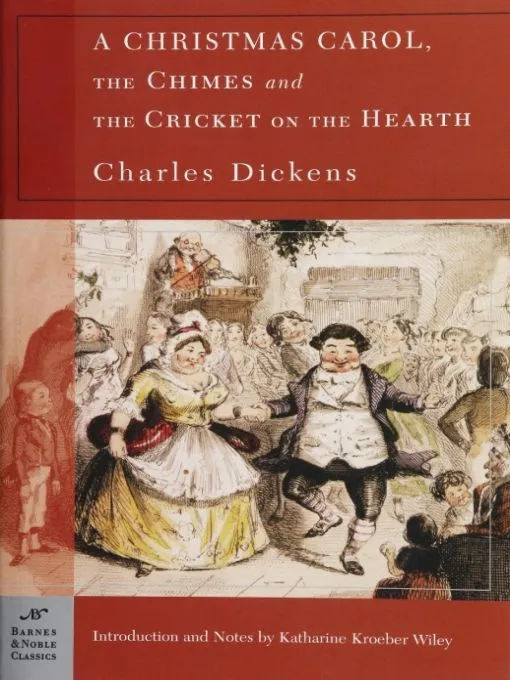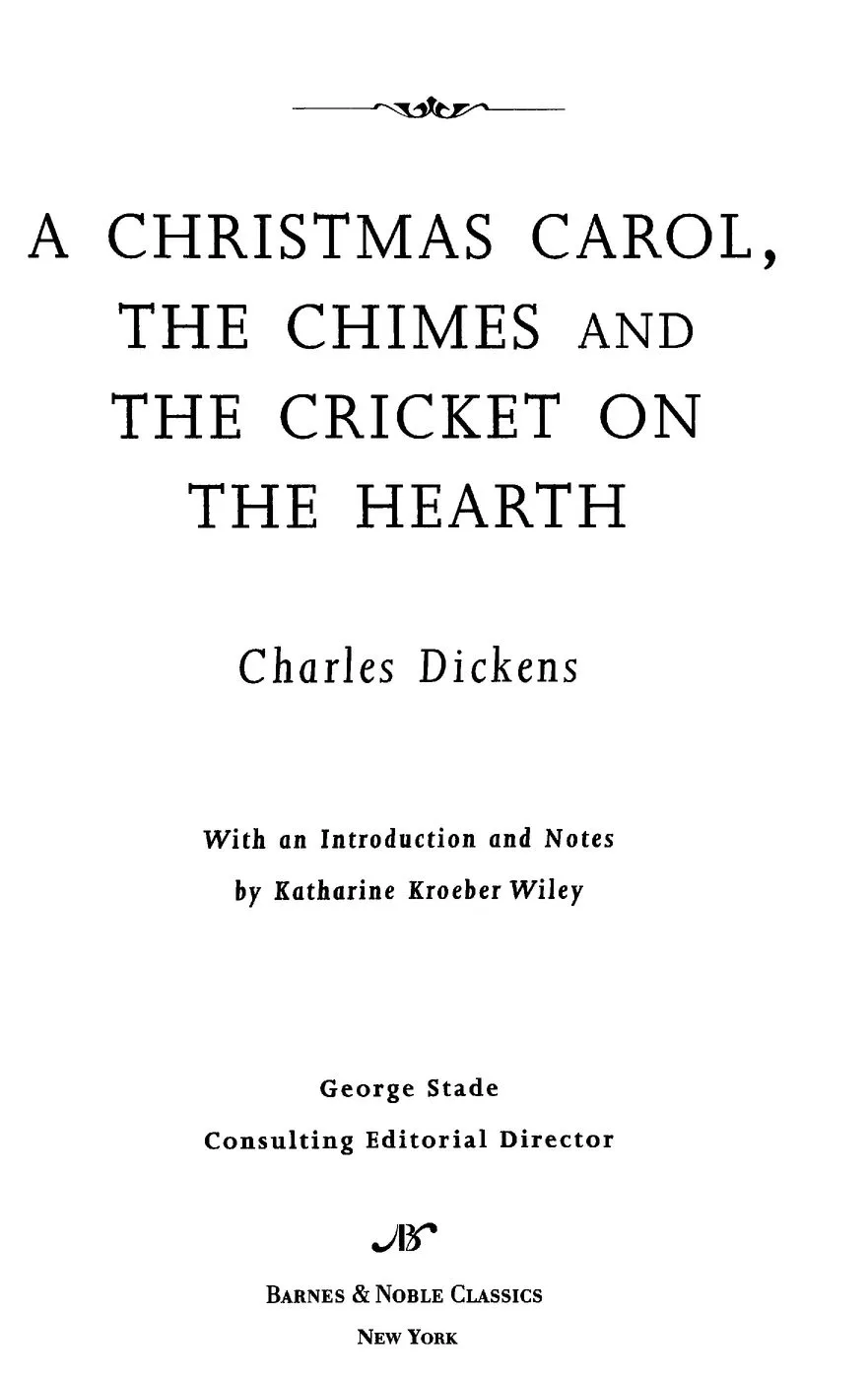Christmas Carol, The Chimes & The Cricket on the Hearth (Barnes & Noble Classics Series)

Table of Contents
FROM THE PAGES OF A CHRISTMAS CAROL, THE CHIMES AND THE CRICKET ON THE HEARTH
Title Page
Copyright Page
CHARLES DICKENS
THE WORLD OF CHARLES DICKENS AND A CHRISTMAS CAROL, THE CHIMES AND THE CRICKET ...
Introduction
PREFACE
A CHRISTMAS CAROL, IN PROSE. - BEING A GHOST STORY OF CHRISTMAS
STAVE ONE. - Marley’s Ghost.
STAVE TWO. - The First of the Three Spirits.
STAVE THREE. - The Second of the Three Spirits.
STAVE FOUR. - The Last of the Spirits.
STAVE FIVE. - The End of It.
THE CHIMES. - A GOBLIN STORY OF SOME BELLS THAT RANG AN OLD YEAR OUT AND A NEW ...
FIRST QUARTER.
SECOND QUARTER.
THIRD QUARTER.
FOURTH QUARTER.
THE CRICKET ON THE HEARTH. - A FAIRY TALE OF HOME.
CHIRD THE FIRST
CHIRP THE SECOND
CHIRP THE HIRD
INSPIRED BY A CHRISTMAS CAROL
COMMENTS & QUESTIONS
FOR FURTHER READING
FROM THE PAGES OF A CHRISTMAS CAROL, THE CHIMES AND THE CRICKET ON THE HEARTH
Oh! But he was a tight-fisted hand at the grindstone, Scrooge! a squeezing, wrenching, grasping, scraping, clutching, covetous, old sinner! Hard and sharp as flint, from which no steel had ever struck out generous fire; secret, and self-contained, and solitary as an oyster. The cold within him froze his old features, nipped his pointed nose, shrivelled his cheek, stiffened his gait; made his eyes red, his thin lips blue; and spoke out shrewdly in his grating voice. A frosty rime was on his head, and on his eyebrows, and his wiry chin. He carried his own low temperature always about with him; he iced his office in the dog-days; and didn’t thaw it one degree at Christmas.
(from “A Christmas Carol,” page 10)
Scrooge having no better answer ready on the spur of the moment, said, “Bah!” again; and followed it up with “Humbug!”
(from “A Christmas Carol,” page 12)
In came little Bob, the father, with at least three foot of comforter exclusive of the fringe hanging down before him; and his threadbare clothes darned up and brushed, to look seasonable; and Tiny Tim upon his shoulder. Alas for Tiny Tim, he bore a little crutch, and had his limbs supported by an iron frame!
(from “A Christmas Carol,” page 53)
“God bless us every one!”
(from “A Christmas Carol,” page 55)
The Spirit stood among the graves, and pointed down to One.
(from “A Christmas Carol,” page 80)
“I will honour Christmas in my heart, and try to keep it all the year.”
(from “A Christmas Carol,” page 81)
“I am as light as a feather, I am as happy as an angel, I am as merry as a school-boy. I am as giddy as a drunken man. A merry Christmas to everybody! A happy New Year to all the world! Hallo here! Whoop! Hallo!” (from ”A Christmas Carol,“ page 82)
High up in the steeple of an old church, far above the light and murmur of the town, and far below the flying clouds that shadow it, is the wild and dreary place at night: and high up in the steeple of an old church, dwelt the Chimes I tell of.
(from “The Chimes,” page 93)
The New Year, like an Infant Heir to the whole world, was waited for, with welcomes, presents, and rejoicings.
(from “The Chimes,” page 117)
The kettle began it, full five minutes by the little waxy-faced Dutch clock in the corner, before the Cricket uttered a chirp.
(from “The Cricket on the Hearth,” page 182)
“Every man thinks his own geese swans.”
(from “The Cricket on the Hearth,” page 215)
“Friends, one and all, my house is very lonely to-night, I have not so much as a Cricket on my Hearth. I have scared them all away. Be gracious to me; let me join this happy party!”
(from “The Cricket on the Hearth,” page 264)


Published by Barnes & Noble Books
122 Fifth Avenue
New York, NY 10011
www.BookishMall.com.com/classics
A Christmas Carol was first published in 1843. The Chimes appeared the following
Christmas, and The Cricket on the Hearth, written in 1845, was published in 1846.
Published in 2004 with new Introduction, Notes, Biography, Chronology,
Inspired By, Comments & Questions, and For Further Reading
Introduction, Notes, and For Further Reading
Copyright © 2004 by Katharine Kroeber Wiley.
Note on Charles Dickens, The World of Charles Dickens and A Christmas Carol,
The Chimes and The Cricket on the Hearth, Inspired by A Christmas Carol,
and Comments & Questions
Copyright © 2004 by Barnes & Noble, Inc.
All rights reserved. No part of this publication may be reproduced or
transmitted in any form or by any means, electronic or mechanical,
including photocopy, recording, or any information storage and
retrieval system, without the prior written permission of the publisher.
Barnes & Noble Classics and the Barnes & Noble Classics colophon
are trademarks of Barnes & Noble, Inc.
A Christmas Carol, The Chimes and The Cricket on the Hearth
ISBN-13: 978-1-59308-033-4
ISBN-10: 1-59308-033-6
eISBN : 97-8-141-14319-1
LC Control Number 2003114357
Produced and published in conjunction with:
Fine Creative Media, Inc.
322 Eighth Avenue
New York, NY 10001
Michael J. Fine, President & Publisher
Printed in the United States of America
QM
5 7 9 10 8 6 4
CHARLES DICKENS
Born on February 7, 1812, Charles Dickens was the second of eight children in a family burdened with financial troubles. Despite difficult early years, he became the best-selling writer of his time.
In 1824 young Charles was withdrawn from school and forced to work at a boot-blacking factory when his improvident father—in fact, his entire family, except for him—was sent to debtor’s prison, where they remained for three months. Once they were released, Charles attended a private school for three years. The young man then became a solicitor’s clerk, mastered shorthand, and before long was employed as a Parliamentary reporter. When he was in his early twenties, Dickens began to publish stories and sketches of London life in a variety of periodicals.
It was the publication of The Pickwick Papers (1836-1837) that catapulted the twenty-five-year-old author to national renown. Dickens wrote with unequaled speed and often worked on several novels at a time, publishing them first in monthly installments and then as books. His early novels Oliver Twist (1837-1838), Nicholas Nickleby (1838-1839), The Old Curiosity Shop (1840-1841), and A Christmas Carol (1843) solidified his enormous, ongoing popularity. When Dickens was in his late thirties, his social criticism became biting, his humor dark, and his view of poverty darker still. David Copperfield (1849-1850), Bleak House (1852-1853), Hard Times (1854), A Tale of Two Cities (1859), Great Expectations (1860-1861), and Our Mutual Friend (1864-1865) are the great works of his masterful and prolific later period.
In 1858 Dickens’s twenty-three-year marriage to Catherine Hogarth dissolved when he fell in love with Ellen Ternan, a young actress. The last years of his life were filled with intense activity: writing, managing amateur theatricals, and undertaking several reading tours that reinforced the public’s favorable view of his work but took an enormous toll on his health.
1 comment